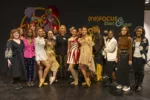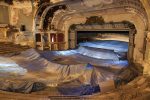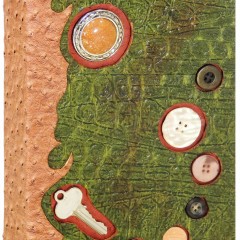—>Sam visits the Athenaeum for an encounter with Edgar Allen Poe’s moody words in a Hidden City Festival project. — the Artblog editors—————>
A visit to Through the Pale Door, Ruth Scott Blackson’s installation inside the historic Philadelphia Athenaeum, begins with a guide leading you to the private library’s third-floor reading room. There, you will find Blackson’s creation: a trilogy of artist’s books, printed at the local Second State Press, each modeled on the colors in individual rooms in Edgar Allan Poe’s 1840s home on Seventh and Spring Garden streets. Page by page, each book pulls color swatches from the Poe house, matched with writings by the inimitable author-poet that reference those same hues. Each swatch is a shade that perfectly matches the emotions evoked by Poe’s words, whether it be a feeling of dread or one reminiscent of Poe’s delightful gallows humor.
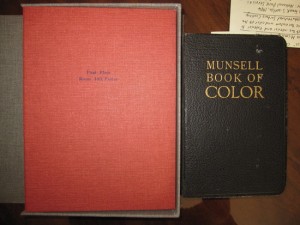
One important rule I’ve learned from experiencing a number of Hidden City Festival projects around the city: do not plan on darting from site to site and expect to get meaningful satisfaction out of them. That’s especially true at Through the Pale Door.
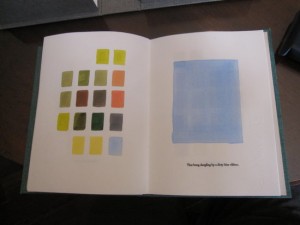
Shades of brown and yellow match words about death and brown stout
In one artist’s book, “A Cadaverous Hue,” a quote from Poe’s 1845 short story, “The Facts in the Case of M. Valdemar,” is printed beside a sickly yellow swatch. On another page, the line “It is possible, however, that, but for the Brown Stout, I might have been a little nervous,” from “Some Words with a Mummy,” is printed with a humorously hearty shade of brown. Perusing each artist’s book becomes a visually rich experience similar to that of reading a Poe story, through brief snippets of his words and the haunting beauty of Blackson’s colors. For, as the master of the macabre wrote in “The Black Cat,” “Words have no power to impress the mind without the exquisite horror of their reality.”
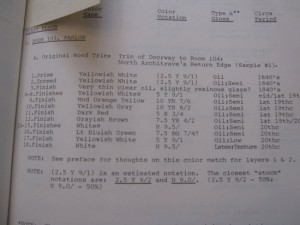
History of the project – Poe’s signature, his house, lost wall colors and a color guide book
Blackson’s installation was inspired firstly by the fact that Poe’s signature was recorded in the Athenaeum’s visitor log on November 19, 1838. The next step was finding the “Comparative Microscopic Paint and Color Analysis” report by one Frank Welsh in the Athenaeum’s collection, made in 1984 for the National Park Service. The report details the original colors from Poe’s Philadelphia home, based on the few remaining flecks of paint on the walls.
Poe’s home was converted into a museum by Richard Gimbel, who bought the house in 1933 and stripped the walls of the original colors that likely inspired or at least affected Poe while he lived in Philadelphia. Welsh’s report describes colors in written notations based on the Munsell color system. This system, devised by Albert Munsell around the turn of the century, defines all colors in the rainbow based on three of their attributes— hue, value and chroma. The complexities of color theory can’t possibly be explained within this review, but suffice it to say that recreating colors from their Munsell system descriptions is no small feat.
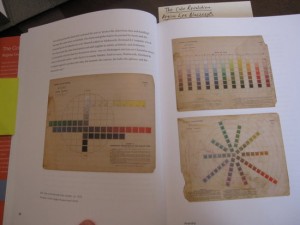
With all this material to consider, a visitor to “Through the Pale Door” begins by flipping through Blackson’s artist’s books, and ends by studying the intricacies of color theory systems. Blackson has generously provided a wealth of reading material — a selection of books on Poe, color theory and the significance of authors’ homes, all handily bookmarked to point guests in the direction of their most significant passages.
Expecting a brief visit, I wound up hunched in the corner, feverishly pulling books and flipping through them in a desperate search for a clarifying vein of commonality. In the words of the master, “I became insane, with long intervals of horrible sanity.”
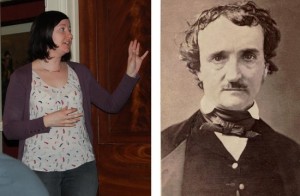
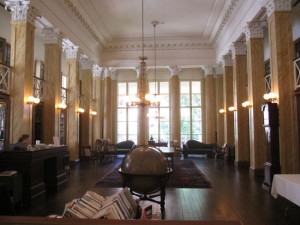
Despite the wide array of disparate elements present in this piece, something in it clicks. Blackson has stepped “through the pale door” in time, as it were, to imagine the black-and-white past of Poe’s life in vivid color. We are invited by Blackson’s artist’s books to imagine not only the colors of the interior of Poe’s home, but also, in a distinctly Poe-esque, Gothic sense, the inside of his mind.
Blackson’s clear affection for investigating arcane documents and finding hidden treasures is evident. She not only took on the cumbersome task of decoding the Munsell system, but also artfully arranged the exhibition to invite visitors on the same path of intellectual exploration.
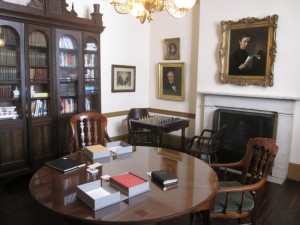
Perhaps the visitor’s journey is the meaning of Through the Pale Door – the experience of you, the lay person, gaining new knowledge about Poe and color theory, and perhaps developing a desire to seek out what other ghosts the Athenaeum’s collection may have to offer.
Poe’s description from the poem “Dream-land,” an ode to dreams, seems applicable : “There the traveller meets aghast/ Sheeted Memories of the Past.”
Through the Pale Door is open Thursday-Sunday, 12 to 7 p.m., through June 30, as are all Hidden City Philadelphia sites.


